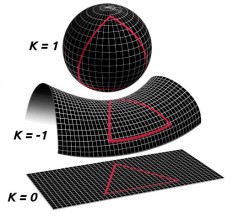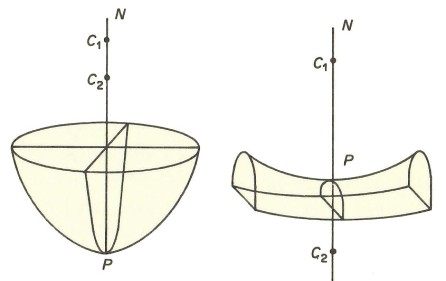
characterizes the intrinsic geometry of a surface.
What is remarkable about Gauss’s theorem is that the total curvature is an intrinsic quantity. Imagine a geometer living on a two-dimensional surface, or manifold as Riemann called it. The Gaussian curvature can be calculated from measurements that the geometer can make within the surface. It is not necessary to have any information about the higher-dimensional space in which the surface is embedded. This caused the normally restrained Gauss to use the adjective egregium, variously translated as outstanding, exceptional, extraordinary or amazing.
As Lanczos (1970) put it, `In view of his customary reticence, it was an exceptionally jubilant gesture to call one of his theorems “Theorema egregium”. Indeed, his new revelation was so dazzling that he could not but feel that others who claimed to do something important in the field of parallels trailed far behind him.’ The phrase which I have underlined here indicates the close link between the sign of the total curvature and the character of the geometry on the surface.
First and Second Fundamental Forms
Gauss introduced general coordinates to specify any point on a surface. The cartesian coordinates
are functions of these, so that
An obvious example is the latitude-longitude coordinate system on the surface of the spherical earth. By generalizing the theorem of Pythagoras, the line element on the surface can be written
where the coefficient functions are
Equation (1) is known as the first fundamental form of the surface. We note that the functions ,
and
depend only upon values within the surface. They are intrinsic quantities, independent of the space in which the surface is embedded. The first fundamental form (1) contains everything that is required to develop geometry on a two-dimensional surface or manifold. It enables us to calculate the lengths of curves on the surface and the areas of regions on the surface. The geometry may be Euclidean or non-Euclidean, or indeed a combination of these types, depending on the values of the coefficients in (1).
The second fundamental form introduced by Gauss is
where
The functions ,
and
are extrinsic: they depend upon the embedding space external to the surface, not just on values within the surface itself. Gauss showed that the entire extrinsic geometry of the surface could be characterized by the second fundamental form.
Principal Curvatures and Total Curvature
If a vector is normal to the surface, any plane containing
cuts the surface in a curve, with curvature
. The principal curvatures,
and
, are the maximum and minimum values of
, and they occur for planes in two orthogonal directions, the principal directions. Gauss focussed on the product of the principal curvatures

surface of (left) positive curvature and (right) negative curvature.
Gauss showed that could be expressed in terms of the coefficients in the first and second fundamental forms. What we now call the total curvature, or Gaussian curvature, may be defined as
The quantities in the numerator depend on values in the 3-dimensional space in which the surface is embedded. The quantities in the denominator are intrinsic quantities.
Gauss then showed that the curvature could be expressed purely in terms of intrinsic quantities. In the case of orthogonal coordinates, for which
, his expression is
This may also be written in the form
Both of these expressions are intrinsic. The value of determines the nature of the geometry that describes the surface. In the simplest case where
is constant, we have Euclidean geometry for
, elliptic geometry for
and hyperbolic geometry for
.
Gauss’s theorem on curvature was made in connection with his development of geometry beyond the limitations of Euclid. It was Gauss who introduced the term non-Euclidean Geometry, although he did not publicize his discovery, fearing that it would meet with a hostile reception. In a letter to Bessel in 1829, He wrote “I fear the cry of the Boetians if I were to voice my views.”
Sources
Lanczos, C., 1970: Space Through the Ages. Academic Press, 320pp.
